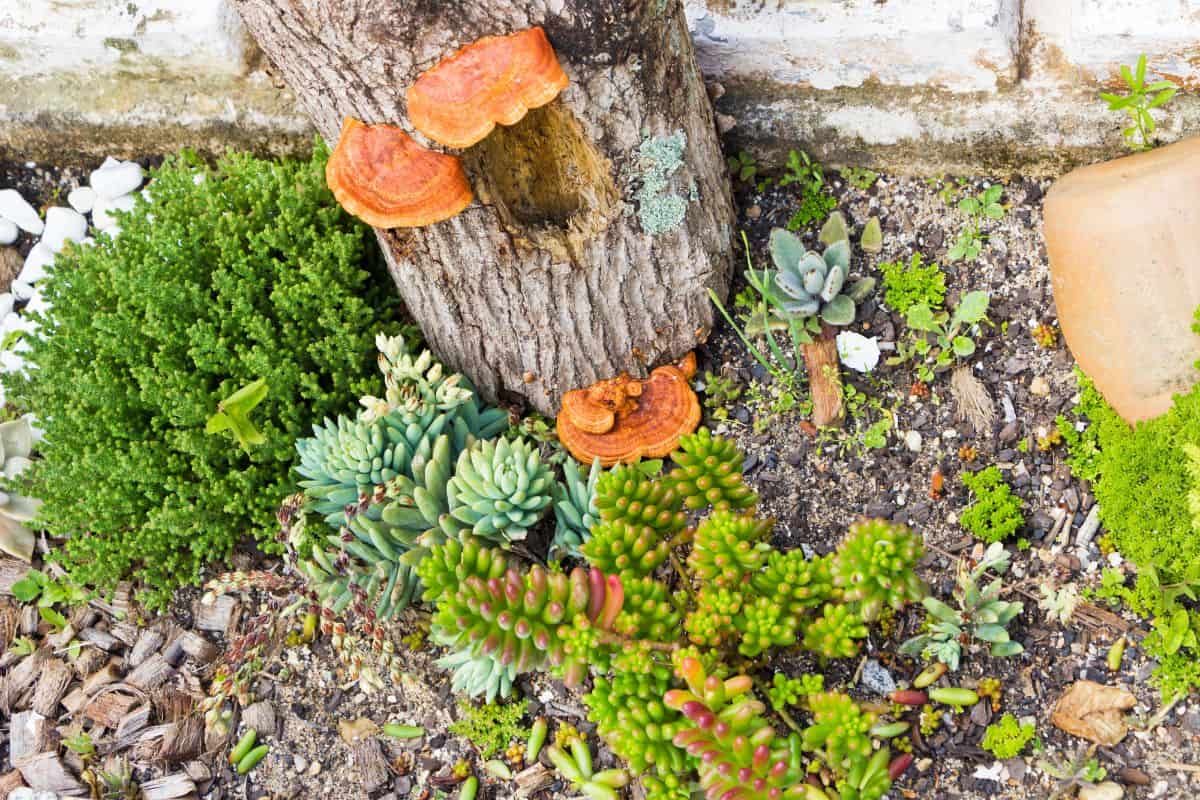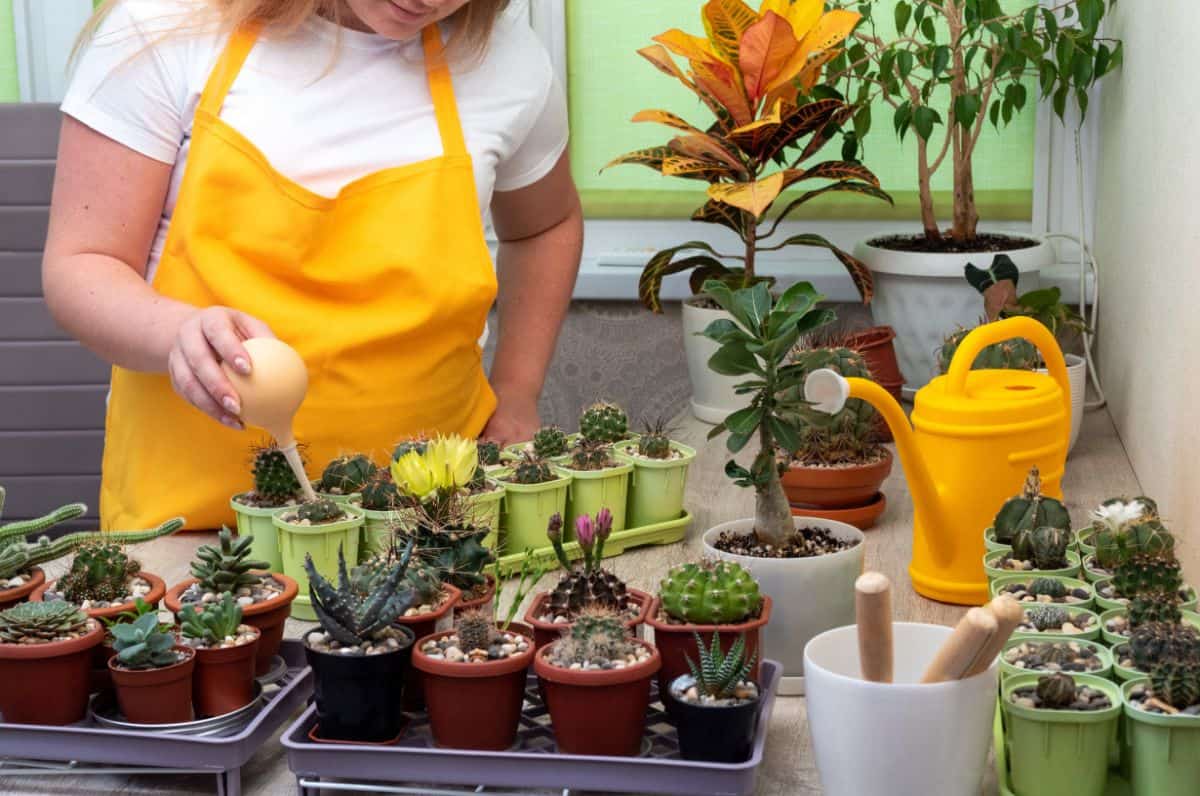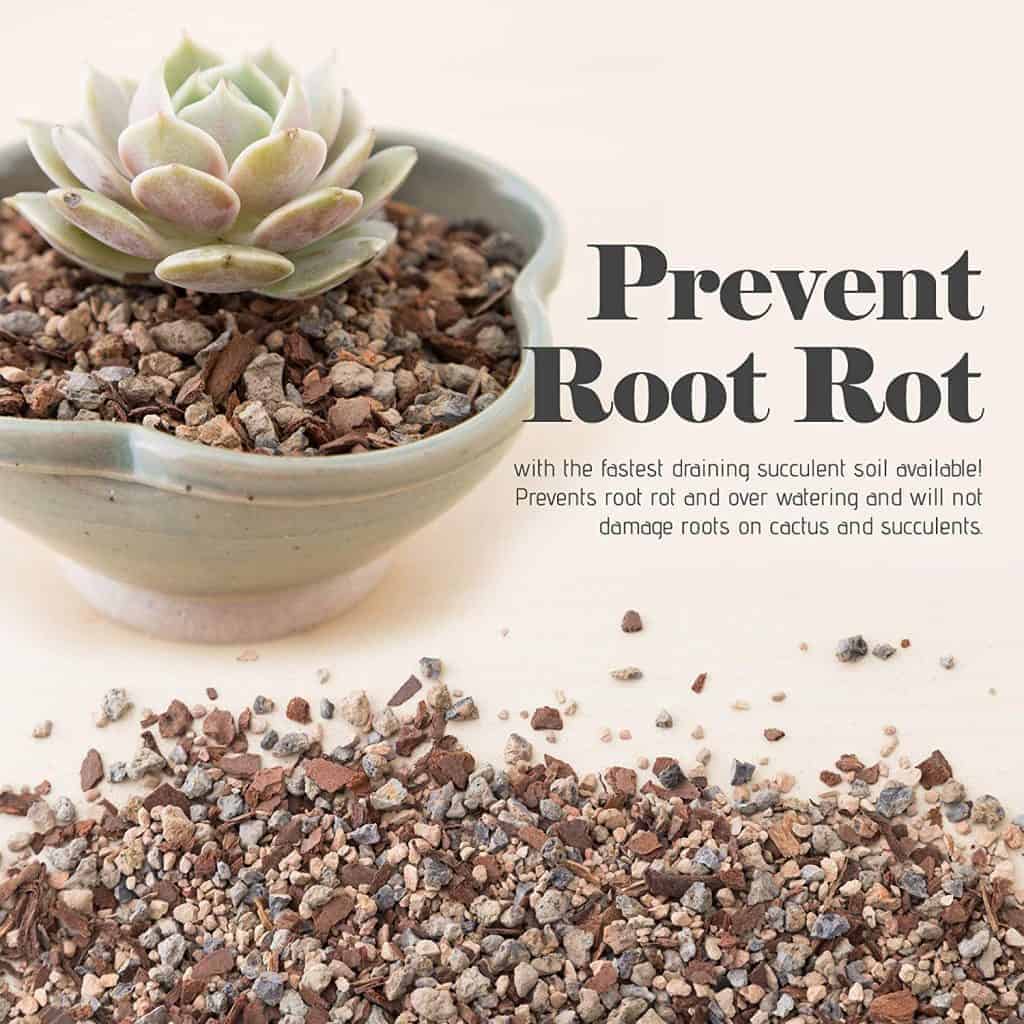It happens to everyone eventually. You see a little yellow or white mushroom emerging from the soil and you start to freak out - "Why is there a mushroom growing next to my cactus!? Will my succulent die?? Is the mushroom eating it?!"

Don't worry. You're (probably) fine, and so is the succulent.
Jump to:
Why are there mushrooms growing with my succulents?
I'll cut to the chase. If there are fungi growing in the same pot or ground as your succulents and cacti it means that the soil is too moist.
The vast majority of fungi (mushrooms, molds, mildew, etc.) absolutely require a damp environment. Their mycelium, which is kind of like plant roots, is very fast to wither in dry conditions. Here are some other conditions fungi thrive in:
- Places that are humid. Moisture in the air means there is also going to be moisture in the soil because it evaporates out much more slowly.
- Environments that have still, stale air. Lots of airflow usually removes humidity.
- Soil that is particularly rich in decomposing organic matter. Things like decaying leaves or roots and shredded bark or coconut coir all provide a great habitat for fungi to thrive.
Read Also:
- How to Stop Squirrels Eating Your Succulents
- Purchasing Wholesale Succulents for Businesses and Landscaping
Are mushrooms harmful to my succulents?

No, not usually. Most fungi, especially the ones that pop up in your pots, are not harmful to plants.
As a matter of fact, they're probably beneficial. There are lots of species of fungi that form what is called a "mycorrhiza" - a symbiotic relationship between a fungus and a plant's roots. The fungus (aided by some bacteria) turns nitrogen into a form usable by plants - and shares it with the plant through their roots! It also helps to protect the plant from infection by acting as the first layer of defense against soil pathogens.
No products found.
In return, the plant shares the sugar it creates through photosynthesis with the fungus. This mutually beneficial relationship is staggeringly widespread. Scientists estimate that up to 90% of the world's plants have a mycorrhizal relationship with fungi.
So to reiterate, no, the mushroom you see won't hurt your succulents or cacti. It could even help it, but...
Your succulent would almost certainly be better off without it.
By creating an environment which allows mushrooms to flourish you're inadvertently harming your succulents. That damp dirt is likely slowing succulent growth and possibly even putting it at risk of root rot. The benefit the fungus might give is not worth the danger you would be putting your succulent in.
Read Also: How to Revive a Dying Succulent
How to prevent mushrooms growing in my pots.
Even though we've established that the mushroom probably aren't harmful, some people don't want them growing alongside their succulents anyway. Perhaps they think mushrooms caps are unappealing... or it's a constant reminder of their failure to water appropriately 😉
Here are a couple ways to prevent more mushrooms from popping up in your plant pots.
Reduce Watering

Had the succulents been watered correctly in the first place, it's unlikely the mushrooms would have ever shown up! Chances are that you need to reduce the frequency of watering, not the amount. A good rule of thumb is to water succulents and cacti about once every 10 days, but that can vary. Read up the best practices with this in-depth guide to succulent watering.
Read Related Topic: How to Treat Scale on your Succulents and Cacti
Use Gritty Soil
Even if you've got watering down perfectly, bad soil can still foil your attempts at good succulent parenting. Soil that is too rich in organic matter tends to retain a lot of water, keeping the dirt wet for days. That's a recipe for both fungi and root rot.
You need to use a grittier soil. That means a soil mix with more large inorganic particles (like perlite or turface) and less organic material (compost, peat moss etc.) You can make it yourself (here's a guide about soil including a recipe for succulent soil). There are also commercially-available gritty succulent and cacti soil - the best one is Bonsai Jack hands down.
How to remove mushrooms growing in my pots.

Preventing mushrooms is all well and good, but if they're already there... what is an anti-fungi (maybe even anti-fun guy) to do?
It's a little more difficult than you might think to get rid of a fungus. It's not as simple as plucking out the mushroom. The reason for the difficulty has to do with their unusual anatomy.
You see, most of a fungus actually lives underground. The bulk of the organism is made up of "mycelia" (plural of mycelium) which are basically like plant roots and stems all rolled into one structure. The mushrooms that we are so familiar with is actually just the reproductive organ of the fungus - it's analogous to a plant's flower. Just like flowers, they show up every now and then, live for a few weeks, then die.
Even when a mushroom isn't there, the fungus is still doing it's thing underground. We rarely think about it, though, because "out of sight, out of mind".
Replace the Soil
Even if you destroy all of the mushroom you see, it won't harm the body of the fungus (the mycelia). There's also no realistic way to remove mycelia from soil - it's so fine and so well-ingrained that you could never remove all of it.
If you want to get rid of a fungus, you're going to have to throw out the soil.
That's not a huge deal - succulents really don't mind being repotted. It is an inconvenience to get new, sterile soil however. To be totally clear: most soil, even commercial ones, probably already have bits of mycelia in them which, like succulent leaves, are able to regrow the whole organism. In order to kill any fungus or other soil pests, you'll need to sterilize the soil before you use it. The simplest way is to spread it in a baking sheet and put the soil in the oven at 250 degrees F for 15 minutes.
Use a Fungicide
If you're serious about those dang mushrooms, you may want to use a fungicide.
It really shouldn't be necessary - between good watering techniques and good soil composition, mushrooms shouldn't ever show up. If you want the mushrooms gone now and you're not in the mood to repot, you'll need one of the many available commercial fungicides. Follow the directions on the packaging, but in general you need to dilute it with water and then soak the soil containing fungi.
You don't need to worry about the plant - fungicides won't harm plants, although some of them are lethal to insects. Don't use it on outdoor plants. You will kill the native fungi which is bad for your soil health and may possibly harm beneficial insects as well.



Binks
Thank you for such an excellent, clear article! Now I'm off t o re-pot my succulent...
Patrick Grubbs
Glad it helped! Best of luck, I'm sure your succulent will be grateful!!
Melanie
This article is very informative! Thank you!
Patrick Grubbs
Glad to be of help!
Laura
hi,
You mention succulents, can the same be applied to a Cactus?
Patrick Grubbs
Yes, cacti are succulents so this applies to them too!
Ted Barendrecht
Hi Patrick, Thank you for the article I think I've got leucocoprinus ianthinus growing along side my cactus and aloë Vera. For both I used the same pack of soil. All my other plants are fine... no coincidence I think.
Is it dangerous to to your health if you have the mushrooms in your home? Breathing the spores? I moved all infected plants outside just to be safe. Also is it really needed to repot or can I just let the mycelium dry out so that it dies? Thank you!
Patrick Grubbs
Most common mushrooms don't produce spores that are harmful to your health, so i wouldn't worry about it. Letting it dry out is the perfect solution 🙂
Ted Barendrecht
Thanks a lot 🙂
Darrell E. RisonChu
Condescending.
Learn to write to readers that may not understand the nature of “nature” and stop jabbing them with insults. Keep in mind, some of this is new to us. You should’ve learned that along time ago. As a caveat why are you plant people so critical? We are doing our best and yet you castigate us? Shame on you.
Dorian Mead
Honestly, I think you need to take a chill pill, you talk about how the entire community is toxic whenever you calling people condescending is the source of it. If you have a brain then you'll understand that the person that wrote this article has nothing against you and you should stop taking it so seriously. If you are that easily offended, then I think the internet isn't the right place for you.
Dorian Mead
Also, I don't think you have any kind of authority over how the writer writes, you were drawn to this article which is already good on the writer, and you insult them like they just spat in your face. Maybe if you care so much than you should learn instead of asking the author to simplify what their saying. Have you ever wondered why they have been "Jabbing readers with insults"? It's because your too much of a simpleton to understand. Honestly you've just lowered the bar.
Roger Gawne
Hi! Thank you so much for this article— super helpful and informative, even to a plant noob like me! Lol!
Anyways, my succulent has a mushroom, unsurprisingly— it would seem letting the fallen leaves just hang out in the soil wasn’t the best idea. Do I need to remove the mushroom? Or will clearing out the old leaves and watering the plant less be sufficient for keeping the succulent safe? While I obviously don’t want to invite more mushrooms or put my plant at risk, I have nothing against the little fun-guy if he’s not doing any harm.
Lastly, I am a little sad that the soil type is a major cause. I specifically bought succulent soil for my two succulents ? ah, well. We do our best.
Patrick Grubbs
Yeah, commercial succulent soil (*cough cough* miracle gro) is really only halfway to decent succulent soil. You should amend it with more perlite.
Clearing out old leaves and watering less will be sufficient! No need to remove the mushroom - that's just the "flower" of the actual fungus, which is all in the soil (and not really bothering your plants anyway)